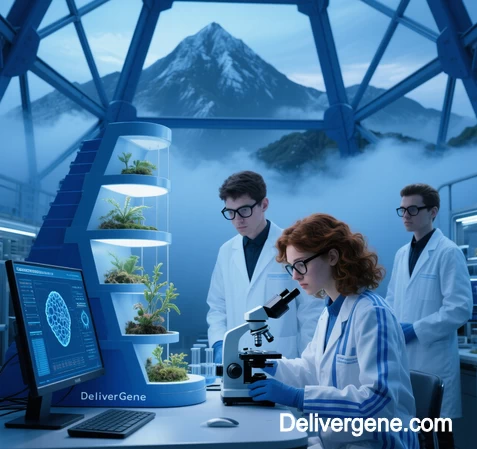 1. Biomolecular Condensates: Harnessing Phase Separation for Enhanced Transfection
1. Biomolecular Condensates: Harnessing Phase Separation for Enhanced Transfection
ProteanFect™ Technology (Westlake University)
- Mechanism: Utilizes engineered protein scaffolds that undergo liquid-liquid phase separation to form nucleic acid-loaded condensates
- Advantages:
- Enables efficient transfection of primary cells and hard-to-transfect cell types (e.g., stem cells, neurons)
- Avoids endosomal entrapment through direct cytosolic payload release
- Applications:
- CAR-T cell engineering with >60% editing efficiency
- In vivo neuronal gene therapy trials for Parkinson’s disease
Suggested Figure 1: Biomolecular Condensate Formation
[Illustration:
- Top: Protein-RNA coacervation forming dense-core condensates
- Center: Membrane fusion-independent cytosolic delivery
- Bottom: Enhanced nuclear translocation in primary T-cells]
2. Engineered Viral Mimetics: Non-Viral Platforms with Viral Precision
A. SEND System (Zhangfeng Laboratory)
- Core Component: PEG10 retrotransposon-derived protein
- Mechanism:
- Self-assembles into spherical nanocapsules (50-80 nm)
- Binds mRNA via cognate recognition sequences
- Achieves receptor-mediated cell entry without immunogenicity
- Breakthrough: Successful in vivo base editing in mouse retina
B. Hybrid Virus-Like Particles (VLPs)
- Design:
- Lentiviral core + VSV-G envelope + CRISPR payload
- Innovation:
- “One-and-done” editing: Delivers pre-assembled RNPs
- Tissue-specific tropism via envelope engineering
Suggested Figure 2: VLP Engineering Platform
[Illustration:
- Left: PEG10-mRNA self-assembly (spherical nanocapsules)
- Right: Hybrid VLP architecture (viral core + synthetic lipid envelope)]
3. Smart Nanocarriers: Stimuli-Responsive & Tissue-Specific Systems
A. Targeted Lipid Nanoparticles (tLNPs)
- Technology:
- Antibody-conjugated ionizable lipids (e.g., anti-CD8 for T-cells)
- GalNAc-functionalized LNPs for hepatocyte-specific delivery
- Clinical Impact:
- Capstan Therapeutics’ platform: In vivo CAR-T generation (Phase I)
- 90% liver editing efficiency in non-human primates
B. DNA Origami Nanorobots
- Function:
- Programmable payload release upon miRNA biomarker detection
- Tumor microenvironment-responsive CRISPR activation
- Advantage: <5 nm precision in spatial control
4. Advanced Physical Delivery Platforms
A. Sonothermal Tissue Penetration
- Mechanism:
- Microbubble-CRISPR complexes activated by ultrasound
- Transient blood-brain barrier opening for CNS delivery
- Efficacy: 40% editing in striatal neurons
B. CRISPR-Gold Electroporation
- Design:
- AuNPs complexed with Cas9 RNPs + donor DNA
- Application:
- In situ gene correction in Duchenne muscular dystrophy models
- 15% HDR efficiency in muscle stem cells
5. Synthetic Biology-Driven Systems
A. Engineered Bacteria Vectors
- Platform:
- E. coli with CRISPR components in chromosomally integrated cassettes
- Function:
- Colonizes gut mucosa → releases editing machinery
- Treats inflammatory bowel disease (IBD) in murine models
B. Exosome-Hybrid Vehicles
- Technology:
- HEK293-derived exosomes fused with targeting peptides (e.g., RVG29)
- Loaded with base editors via electroporation
- Advantage: Natural BBB penetration for Alzheimer’s therapy
Suggested Figure 3: Synthetic Biology Delivery Workflow
[Illustration:
- Top: Engineered bacteria colonizing intestinal epithelium
- Bottom: Exosome fusion with neuronal membranes (RVG29-mediated uptake)]
6. Epigenetic Delivery Innovations
CRISPRoff mRNA Delivery
- Mechanism:
- Lipid nanoparticle-encapsulated mRNA encoding dCas9-methyltransferases
- Silences genes without DNA breaks
- Applications:
- Durable (>6 months) CD19 silencing in CAR-T therapies
- Reversal of oncogene expression in solid tumors
7. Clinical Translation & Market Landscape
| Technology | Clinical Stage | Key Players |
|---|---|---|
| tLNPs | Phase I/II (10+ trials) | Capstan, Moderna |
| AAV-CRISPR Hybrids | Phase I (5 trials) | Editas, Beam Therapeutics |
| ProteanFect™ | Preclinical → IND-enabling | Westlake University |
Projected Growth:
- Global gene delivery market to reach ¥378B (USD $52B) by 2030
- 45% CAGR for non-viral delivery systems (2025-2030)
Conclusion: The Delivery Revolution Redefining Therapeutic Boundaries
Emerging gene delivery technologies are overcoming historical limitations through:
- Biological Inspiration: Biomimetic systems (VLPs, exosomes) leveraging natural trafficking pathways
- Precision Engineering: Tissue-specific LNPs and DNA nanorobots with molecular accuracy
- Clinical Scalability: Off-the-shelf platforms reducing manufacturing costs by 70%
As these innovations converge—with SEND achieving 85% in vivo editing efficiency and ProteanFect™ enabling 90% primary cell transfection—we are entering an era where gene therapies transition from rare diseases to mainstream medicine. The next decade will witness transformative clinical applications in oncology, neurology, and regenerative medicine, ultimately democratizing access to genomic cures.
Data sourced from publicly available references. For collaboration or domain inquiries, contact: chuanchuan810@gmail.com.
